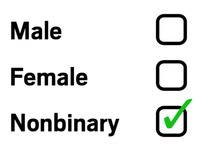 |
| Angelika/Mike Schilli |
|
|
|
Michael When filling out a form, one typically checks either "male" or "female" under "gender." However, gender roles have recently been more fluidly defined, and anyone can be anything or neither. Trendy companies and left-leaning authorities have been offering a third box called "non-binary" for a while now, for those who do not want to identify as either male or female. The term is familiar to computer experts, as "binary" refers to a value that has two possible states and assumes either one or the other.
Now, it's not that simple when someone is neither male nor female, because how do you address a non-binary person, as "he" or "she"? For example, if a colleague wants to point out that a non-binary person works well, do they refer to "her performance" or "his performance"? Do you go to "his" office or "her" office for a meeting? Nowadays, it is not uncommon for employees to be able to specify their "personal pronouns" in the company directory. A man would write "he, him, his," and a woman would write "she, her, hers." The first pronoun is used if the person is the subject of a sentence ("He finished the project"), the second if the person is the object ("Management speaks greatly of him"), and the third if the sentence needs a possessive pronoun ("The backpack I found was his").
If a non-binary person has completed a project, you can't say "he" or "she," and "it" would also sound strange. A commonly chosen combination is "they, them, theirs," so you would say "they finished the project," which actually suggests that it involves multiple people, but the speaker has to clarify that somehow with additional information. It's not so easy if you want to please everyone.
As always with new regulations, unexpected side effects can arise. For example, I know a gentleman who likes to participate in public long-distance runs and always finishes among the top ranks. Just for fun, during registration, he once checked "non-binary" instead of "male" or "female." On the day of the race, he performed exceptionally well, finishing among the first, and was surprised afterward to find that his name was not on the results sheet at all: the sheet listed men and women separately with their finish times, and the computer system simply did not recognize a "Non-Binary" category.
Another piece of evidence for the gender confusion I recently found in a newspaper report about a school in Harford, Connecticut, where female student-athletes were outraged that in their disciplines now also allows Transgender men to compete who dominated the events. The women complained that due to the physical superiority of the ex-men, the outcome was predetermined and the women's competition was becoming a farce.
Conservative-minded citizens naturally recognize the problem now as doubly ironic, because the contradiction between gender separation in competition on the one hand and the softening of gender roles on the other hand constitutes an irresolvable contradiction. Well, the left-liberals who pushed the system through might still find a solution; the whole thing is obviously not fully developed yet. Tip from the expert: It usually pays off to plan carefully and consider side effects before robotically always siding with the one who shouts the loudest.









